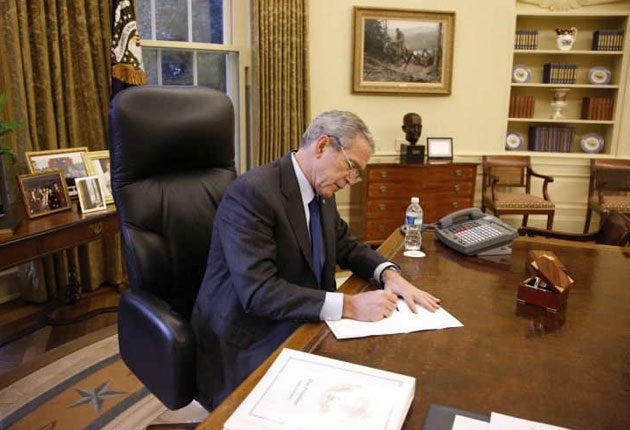As voting begins, Obama plans transition to the White House
Veteran of Clinton era is given task of arranging smooth changeover between election and inauguration

A transition team has been working in secrecy in Washington, preparing the ground for a smooth ascent to power by Barack Obama, should he be elected next Tuesday.
John Podesta, a former chief of staff to Bill Clinton, is heading the team and has been tasked with supplying names which are being vetted for a high level of security clearance by the FBI and the Department of Homeland Security, for inclusion in a new Democratic administration. Secrecy surrounding the arrangements governing the 11-week transition from election to inauguration is such that it is described as "a black box" by one individual familiar with the arrangements.
Mr Podesta, who is also the head of a Washington-based think-tank, the Centre for American Progress, has already distributed a 26-page document to top campaign aides. It describes in fine detail everything the last five presidents did on each day of the transition period from election day to the inauguration on 20 January 2009. Democrats are anxious to avoid a repeat of the Bill Clinton transition in 1992 which did not begin properly until after the election and resulted in a difficult first 100 days.
John McCain has been mocking his opponent for prematurely engaging in a "victory lap", after reports emerged that a draft speech has already been written by Mr Podesta for his inauguration. But Mr McCain also has a transition team in place which is led by the former Navy secretary John Lehman.
Whoever becomes president will face an unprecedented set of challenges ranging from containing the fallout from the global economic mayhem to the war in Iraq, halting Iran's race for nuclear weapons, and the increasingly worrying situation in Afghanistan and Pakistan. All that is without an unexpected domestic crisis rearing up.
Democrats worry also that George Bush could use the transition period to try to secure his own legacy by handcuffing his successor with policy changes forced through by executive order. Political appointees considered ideologically questionable by Democrats are also "burrowing in" to secure career appointments in the federal bureaucracy. Among those lining up to secure high-profile jobs in an Obama administration are many dinosaurs familiar from Bill Clinton's second term, including Mr Podesta himself, and Madeleine Albright, the former secretary of state.
But there is also much to suggest that Mr Obama wants a fresh start. For the past two years he has been surrounded by a tightly knit group of advisers. These include Mark Lippert, his longest-serving foreign policy adviser, who is also an Iraq war veteran. Though hardly a household name, diplomats do not discount the possibility that Mr Lippert could emerge at the head of Mr Obama's team of 300 foreign affairs advisers to be named secretary of state.
As Washington indulges in a frenzy of rumour about the make-up and policies of a possible Obama administration, hot off the presses comes Changing America, a 50-chapter book by Mr Podesta advising the Illinois senator how to run a new Democratic administration.
Mr Obama might ignore Mr Podesta's detailed departmental suggestions, but he and his aides are expected to give serious consideration to many of them. Some indication of Mr Obama's priorities for government came in an answer he gave during the final presidential debate. Asked what sacrifices he would expect of Americans to get the country moving, Mr Obama cited reform of energy consumption. With an economic hurricane battering the country, plans for health care reform may have to make way for keeping people in their homes.
Mr Podesta created the Centre for American Progress think-tank just over four years ago to provide an antidote to the Heritage Foundation, the conservative intellectual powerhouse of the right. Today it has 150 staff and spends more than $25m a year.
Jennifer Palmieri, another former Clinton White House official and now spokeswoman for the centre, describes the organisation as a Democratic "government in waiting". But she expects it to speak out if it disagrees with an Obama administration.
"There will be times we will be an irritant," said Ms Palmieri.
Regime change: How past presidents chose their teams
Jimmy Carter Elected 2 November 1976
A stranger to Washington and anxious to avoid the bunker mentality of the Nixon presidency, Jimmy Carter chose his cabinet well before announcing his White House staff. Five weeks after the election, Cyrus Vance was named as secretary of state. By 23 December, Carter had completed his cabinet selections.
Ronald Reagan Elected 4 November 1980
Reagan's team opened the doors to ideologues from the Heritage Foundation who set about instituting the "Reagan Revolution". Led by Reagan's chief of staff in Sacramento, Ed Meese, the transition team filtered nominees through a "kitchen cabinet" of Reagan's California friends. On 22 December, Reagan added a lone black (Samuel Pierce, housing and urban development) and lone woman (Jeane Kirkpatrick, United Nations) to his cabinet.
Bill Clinton Elected 3 November 1992
The Clinton transition was downright chaotic. In 1992, Warren Christopher ran Bill Clinton's drama-filled transition team and his vice-presidential search.
The first few weeks of the Clinton administration were packed with crises, starting with the nomination of Zoe Baird as his Attorney General. It turned out she had hired two illegal immigrants to work in her home and not paid social security taxes.
Join our commenting forum
Join thought-provoking conversations, follow other Independent readers and see their replies
Comments
Bookmark popover
Removed from bookmarks